- Home
- Robert J. Sawyer
Neanderthal Parallax 3 - Hybrids Page 16
Neanderthal Parallax 3 - Hybrids Read online
Page 16
“Well, it’s different. Um, we have a bigger population, for one thing.”
“How big?”
“Six billion.”
“Six billion! I think you hardly need a device to aid conceptions, then…”
Mary nodded, conceding that. “And males and females live together all the time.”
“Madness! Don’t they get on each other’s nerves?”
“Well…yes, I suppose they do sometimes, but…As I said, it’s a different place. And we have many wonderful things. We have a space station—a permanent habitat orbiting our planet. We have buildings that tower into the sky”—although, Mary thought ruefully, not as many as we used to. “And we have much more varied cuisine.”
“Ponter, have you been there?”
“My daddy’s been there three times now!” said Mega.
“Would I like it?” asked Vissan.
“That depends,” said Ponter. “Do you like it here, in the wilderness?”
“Very much. I have gotten quite used to it.”
“Do smells bother you?”
“Smells?”
“Yes. For power, they burn oil and coal, so there is a stench in their cities.”
“That hardly sounds appealing. I think I will stay here.”
“Whatever makes you happy,” said Mary. “But could you teach us how to operate the codon writer, then?”
Vissan looked at Ponter. “How do you feel about this? I have willingly shed myself of the trappings of civilization, and so the Grays—High or Low—have no authority over me. But you…”
Ponter looked at Mary, then back at Vissan. “I have de-fied the High Grays before; I chose to flout their order to return to this universe so that the portal could be shut down. Indeed, I would still be in Mare’s universe if an ambassador hadn’t convinced others to cross over. And…”
“Yes?”
“And, well, sometimes people are sterilized without it being right, so…”
Ponter trailed off, and Mary spoke up. “He’s referring to his man-mate, Adikor. When Ponter first disappeared into my world, they thought Adikor had killed him and disposed of the body. They were going to sterilize him.” She turned to Ponter. “Isn’t that right, Ponter?”
“What?” said Ponter, his tone odd. “Oh, yes. Yes, that was what I meant, of course…”
“Well, if you are comfortable with having the codon writer,” said Vissan, “I am content to let you have it.” She gestured toward the door. “I’ll go get it. Just don’t ever tell anyone—in this world, at least—that you have it.”
Chapter Twenty-two
“ Likewise, some of our Barast cousins, natives of Europe, came south to Gibraltar, with its famous rock, that wonderful symbol of permanence and stability. And from their vantage point, the Neanderthals could see south to the unknown lands of Africa…”
“Jock, can I have a word with you?”
Jock Krieger looked up from his desk. He was, perhaps, a bit paranoid about showing his appreciation for just how beautiful Louise was. It was a generational thing, he knew—he was thirty-six years older than Louise, after all—but he’d seen some of his colleagues at RAND get in trouble for supposedly sexist comments. “Ah, Dr. Benoît,” he said, rising—that much of the manners his parents had drilled into him he couldn’t suppress. “What can I do for you?”
“Remember when we were talking before about the effect a planetary magnetic-field collapse might have on consciousness?”
“How could I forget?” said Jock. “You said that human consciousness had booted up during a magnetic-field collapse.”
“That’s right. Forty thousand years ago, when the Great Leap Forward occurred, Earth’s magnetic field was undergoing a collapse, just like it’s beginning to now. In our universe, the field came up with its orientation the same as it had been before the collapse—which it will do half the time, leaving no record here. But in the other universe, the orientation came up flipped, and so it was recorded in their geological record. As I said, it couldn’t be a coincidence that hominid consciousness booted during a field collapse, and—”
“And you said this time it might have effects on our consciousness again, possibly even causing a crash.”
“Exactly. Now, when I first suggested that, it was only because of the coincidence that the Great Leap Forward occurred during a time when Earth’s magnetic field had collapsed; obviously, there was a correlation between magnetic fields and consciousness. But since then, I’ve been digging, trying to find what research, if any, has been done about the electromagnetic nature of consciousness—and, frankly, Jock, I’m even more worried than I was before.”
“Why? The Neanderthals have been through one collapse since—the one that began a quarter of a century ago in their world—and they had no problems.” Jock had been astonished when he’d read the research by Coe and Prévot showing that, in fact, his Earth’s geological record provided evidence that field collapses took place in a matter of weeks, not centuries. “If they came through their collapse just fine, why shouldn’t we?”
“As much as I like the Barasts”—calling a Neanderthal a Neanderthal was no longer politically correct, apparently—“they are a different species, with differently constructed brains,” said Louise. “All you have to do is look at their skulls to see that. Just because they came through all right doesn’t mean we will.”
“Oh, come on, Louise!”
“No, really. I’ve been searching the web for information on the relationship between electromagnetic fields and consciousness, and I came across something very interesting called CEMI theory.”
“Semi-theory?” repeated Jock. Perfect name for a half-baked idea…
“CEMI, with a C ,” said Louise. “It’s short for Conscious Electromagnetic Information theory. A couple of researchers independently developed it, Johnjoe McFadden at the University of Surrey and Susan Pockett in New Zealand.” She looked out Jock’s window, apparently gathering her thoughts, then: “Look, we’ve identified all sorts of specific areas in the human brain: where visual images are created, where mathematical operations occur, even—I’m sure you’ve read about this in the press—where the seat of religious feelings is. But the one thing we’ve never located is the physical site, the actual location, of consciousness in the brain. Well, McFadden and Pockett think they’ve found it—not in the brain, but surrounding it and permeating it: an electromagnetic field. Such a field would allow neurons that are separated by great distances in the brain to nonetheless connect with each other, binding together all the little bits of information into an integrated whole, a coherent picture of reality.”
“Wireless communication in the brain?” said Jock, intrigued despite himself.
“Exactly. Back in 1993, Karl Popper proposed that consciousness was the manifestation of a force field in the brain, but he thought it must be some unknown kind of force field, since he’d figured we’d have discovered it already if it consisted of energy we were familiar with. But McFadden and Pockett say the field is simply electromagnetic.”
“And they’ve detected it?”
“Oh, there certainly is electromagnetic activity in and around the brain; that’s what EEGs measure, after all. But remember, our Barast friends have unified electromagnetism and the strong nuclear force—in other words, there’s much more to electromagnetic fields, including both the Earth’s and the ones produced by our brains, than we’ve ever been aware of.”
“But have these researchers you mentioned proved that such fields are actually linked to consciousness?” asked Jock.
Louise brushed dark hair out of her eyes. “No, not yet. And I will admit that there’s a lot of resistance from some quarters to the very notion. Good old René Descartes believed in dualism—the notion that the body and the mind are separate things—but that’s been out of fashion for quite some time now, and, well, some see CEMI as an unwelcomed return to it. But CEMI theory makes sense from an information-processing standpoint. Essentially McFadden and Pockett are say
ing that awareness and information are the same phenomenon viewed from different reference frames, and—”
“Yes, so?”
“Well,” said Louise, “if consciousness is an electromagnetic phenomenon, then it’s perhaps no surprise that its first appearance was during a geomagnetic field collapse. Now, as I said, we know from the recent Barast experience that such a collapse on its own won’t cause problems with consciousness—but I’m a solar physicist, remember. I may specialize in neutrinos, but I’m interested in the whole range of solar radiation—and our brains, with these delicate electromagnetic fields, will be hit by an onslaught of normally deflected solar radiation for years or decades during the collapse. The more I look into this, the more I think a consciousness crash of some sort just might occur.”
“But that’s crazy,” said Jock. “Consciousness can’t be electromagnetic. I had an MRI last year, and I assure you, young lady, that I was fully conscious throughout the procedure.”
“That’s the most common objection to this theory,” said Louise, nodding. “McFadden addressed that directly in his most recent paper in the Journal for Consciousness Studies . He contends that fluid within the brain ventricles effectively creates a Faraday cage, insulating the brain from most external electric fields. And, as for MRIs, he points out that those are static electric fields—changing only the direction of moving charges, and so they don’t have physiological effects. Likewise, Earth’s magnetic field is static and pretty uniform—or was, at least until the collapse began. But changing—as opposed to static—external electromagnetic fields do induce electric currents in the brain. And these do affect brain activity; in fact, there are strict guidelines for repetitive transcranial magnetic stimulation that have to be followed to prevent inducing seizures in normal people.”
“But—but if consciousness is electromagnetic, why can’t we detect it?”
“Actually, we can. Susan Pockett has enumerated all sorts of research that says that the brain’s electromagnetic field does change in replicable ways when experiencing specific qualia: you can measure changes in the brain’s electromagnetic field when you’re looking at something red as opposed to blue, or hearing a middle C instead of a high C, and so on. She’s really good at shooting down objections to this theory. For instance, if the corpus callosum—the bundle of nerves that connects the left and right hemispheres—is severed, you’d expect there to be no communication at all between the two halves of the brain. And yet, except in very contrived situations, split-brain patients perform quite normally; despite there being no physical connection between their two hemispheres, their consciousness is integrated—precisely, says Pockett, because consciousness is manifested in the electromagnetic field that contains the entire brain, not through neural-chemical reactions.”
“So you’re saying—what?—that the two halves of the brain communicate telepathically? Oh, come on!”
“They are communicating, even in the absence of the hard-wired link between them,” said Louise. “That’s a fact.”
“Then why don’t I pick up your thoughts when I’m standing next to you?”
“Well, first, remember the brain is essentially enclosed in a Faraday cage, shielding it. Second, Pockett believes the major oscillations associated with consciousness are in the range of one to one hundred hertz, with most of the power around forty hertz. That means they have a wavelength of about 8,000 kilometers, and the ideal antenna for picking up an electromagnetic signal is one wavelength long. Without either a truly giant receiver or very sensitive equipment, you’d never pick up any part of my consciousness by just being close to me. But that the field is integrated over the volume of a single brain does make sense. One of the big issues in consciousness is the so-called binding problem. Look at that book, there.” She pointed at a volume sitting on Jock’s desk, an old RAND nuclear-warfare study. “One part of the brain recognizes that it’s green. Another part picks out the outline of the object from the background. A third part digs up the word ‘book’ to describe it. We know that’s how the brain works—a bunch of compartmentalized functions. But how do all those bits get bound together, producing the thought that we’re looking at a green thing called a book? CEMI says the electromagnetic field is what does the binding.”
“This is all very speculative,” said Jock.
“It’s all very cutting edge, but it is a good, solid scientific theory that makes falsifiable predictions. I tell you, Jock, I hadn’t thought a lot about exactly what constitutes consciousness until all this stuff with alternative worlds began, but it’s a fascinating area of research.”
“And you’re worried that our consciousness might get scrambled as Earth’s magnetic field collapses?”
“I don’t say anything is going to happen—after all, you are right when you say the Neanderthals went through their own magnetic-field collapse recently and nothing happened to them. But, well, yes—I am worried. And I think you should be, too.”
Chapter Twenty-three
“ But the Neanderthals didn’t cross the Strait of Gibraltar. There, at Gibraltar, we saw the difference between us and them. For, when we saw a new world, just a short distance away, we took it…”
“This,” said Vissan, placing a pale green device on the table in her cabin, “is the prototype codon writer.”
Mary looked at the machine. It was about the size and shape of three loaves of bread, placed end to end—although no Neanderthal would ever think of it that way.
“It can synthesize any string of deoxyribonucleic acid, or ribonucleic acid, if you prefer, as well as the additional proteins needed to manufacture chromosomes or other structures.”
Mary shook her head in wonder. “It’s a life factory.” She looked at Vissan. “In my world, you would have won the Nobel Prize for this—our top honor for scientific work.”
“But here,” said Vissan, “it is banned.” Her voice was bitter. “My intentions were so benign.”
Mary frowned. “What were your intentions?”
Vissan was quiet for a moment. “I have a younger brother who lives in an institution.” She looked at Mary. “We have eliminated most inheritable genetic disorders, but there are still things that can go wrong, things that are genetic but not inherited. My brother has—I don’t know what you call it. He has an extra chromosome twenty-two.”
“Chromosome twenty-one, you mean,” said Mary. Then: “No, of course you don’t. It would be number twenty-two here. We call that Down syndrome.”
“Are the symptoms the same in Gliksins?” asked Vissan. “Mental and physical feebleness?”
Mary nodded. But Down also caused facial abnormalities in Gliksins, including a protruding tongue, a slack jaw, and epicanthic folds even in occidentals. Mary wondered what a Barast with Down syndrome would look like.
“My mother was a member of generation 140. She should have had her first child when she was twenty years old, but failed to conceive then—or when she was thirty. She had me when she was forty, and my brother Lanamar when she was fifty.”
“Conceptions that late in life increase the likelihood of Down in my people, too,” said Mary.
“Because the body’s ability to produce clean sets of chromosomes has deteriorated. I wanted to overcome that—and I did. My codon writer could have eliminated all copying errors, all—”
“All what?” said Mary.
“I’m sorry,” said Christine. “I don’t know how to translate the word Vissan has used. It refers to when there are three chromosomes where there should only be a pair.”
“Trisomy,” supplied Mary.
“Had my parents had access to such technology,” continued Vissan, “letting them output a perfect diploid set of chromosomes despite their age, Lanamar would be normal. And, of course, there are a host of similar conditions that also could be avoided.”
Indeed there are , thought Mary. One in 500 Gliksin children were born with a sex-chromosome difficulty, such as Klinefelter syndrome (two or more X chromosomes and a Y
, or often a mosaic), triple-X syndrome, Turner syndrome (a single X chromosome either completely lacking a mate or with a truncated second sex chromosome), or XYY syndrome, which could predispose males to violence—she suspected Cornelius Ruskin had an extra Y; he certainly had the body type and personality. Other combinations occurred, but they mostly resulted in miscarriages.
“But that’s not all,” said Vissan. “Preventing trisomy and similar disorders was only the initial impetus for my work. Once I got into my research, other wondrous possibilities occurred to me.”
“Yes?” said Ponter.
“Yes, indeed! I wanted to eliminate the randomness in gene selection, leaving the choices of traits up to the parents.”
“How do you mean?” asked Ponter.
Vissan looked at him. “You inherited a bunch of traits from your father and another bunch from your mother; half of your deoxyribonucleic acid came from each of them, and in total, those two halves make up your forty-eight chromosomes. But each sperm you produce has a random selection of all those traits. You—Ponter Boddit—have DNA that contains both your father’s contribution to your eye color and your mother’s, plus your father’s contribution to your hair color and your mother’s, your father’s contribution to your browridge shape and your mother’s, and so on. But your sperm contain only twenty-four chromosomes, with just half your deoxyribonucleic acid. Any given sperm you make will contain either your father’s contribution to a given trait or your mother’s, but not both. One sperm might contain your mother’s contribution to eye color, your father’s to hair color, and your mother’s to browridge shape. Another might have exactly the opposite combination. A third might contain only your mother’s contributions to those things. A fourth, only your father’s. And so on, for all the tens of thousands of different genes you possess. No two sperm you ever produced will likely have the same combination of traits coded into it. The same sort of thing happens in the production of eggs, and, again, it’s a virtual certainty that no two eggs share the same combination of the mother’s mother’s genetic material and the mother’s father’s genetic material.”

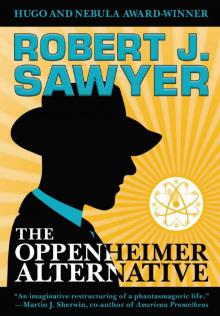 The Oppenheimer Alternative
The Oppenheimer Alternative Factoring Humanity
Factoring Humanity The Shoulders of Giants
The Shoulders of Giants Stream of Consciousness
Stream of Consciousness End of an Era
End of an Era The Terminal Experiment
The Terminal Experiment Far-Seer
Far-Seer Mindscan
Mindscan You See But You Do Not Observe
You See But You Do Not Observe Star Light, Star Bright
Star Light, Star Bright Wonder
Wonder Wiping Out
Wiping Out Flashforward
Flashforward Above It All
Above It All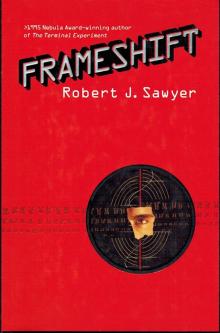 Frameshift
Frameshift The Neanderthal Parallax, Book One - Hominids
The Neanderthal Parallax, Book One - Hominids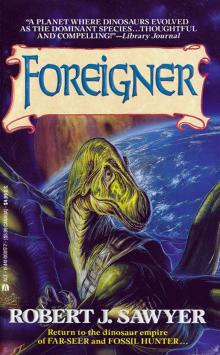 Foreigner
Foreigner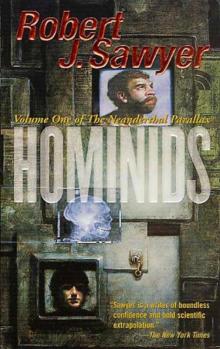 Neanderthal Parallax 1 - Hominids
Neanderthal Parallax 1 - Hominids Relativity
Relativity Identity Theft
Identity Theft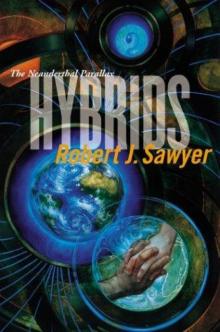 Hybrids np-3
Hybrids np-3 Foreigner qa-3
Foreigner qa-3 WWW: Watch
WWW: Watch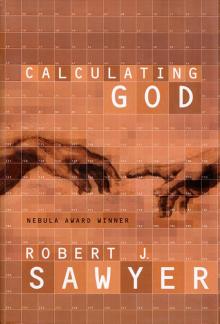 Calculating God
Calculating God The Terminal Experiment (v5)
The Terminal Experiment (v5) Peking Man
Peking Man The Hand You're Dealt
The Hand You're Dealt Illegal Alien
Illegal Alien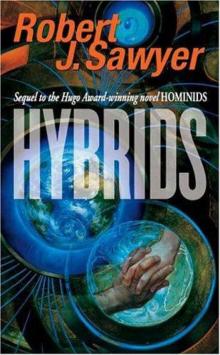 Neanderthal Parallax 3 - Hybrids
Neanderthal Parallax 3 - Hybrids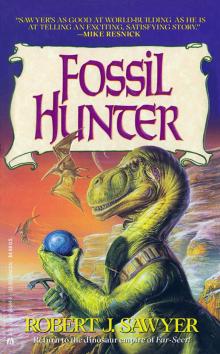 Fossil Hunter
Fossil Hunter WWW: Wonder
WWW: Wonder Iterations
Iterations Red Planet Blues
Red Planet Blues Rollback
Rollback Watch w-2
Watch w-2 Gator
Gator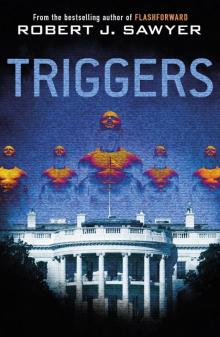 Triggers
Triggers Neanderthal Parallax 2 - Humans
Neanderthal Parallax 2 - Humans Wonder w-3
Wonder w-3 Wake
Wake Just Like Old Times
Just Like Old Times Wake w-1
Wake w-1 Fallen Angel
Fallen Angel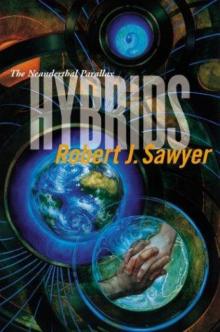 Hybrids
Hybrids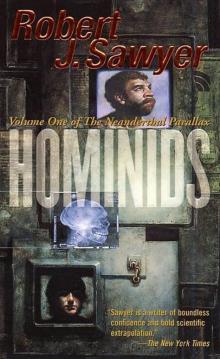 Hominids tnp-1
Hominids tnp-1 Far-Seer qa-1
Far-Seer qa-1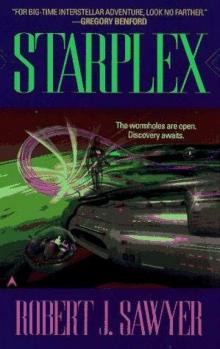 Starplex
Starplex Hominids
Hominids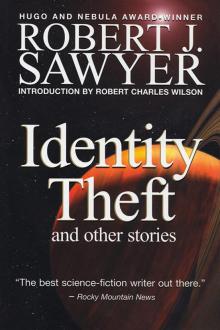 Identity Theft and Other Stories
Identity Theft and Other Stories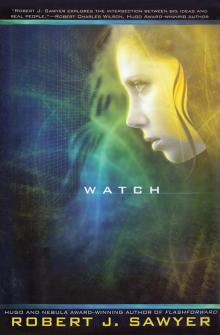 Watch
Watch Golden Fleece
Golden Fleece Quantum Night
Quantum Night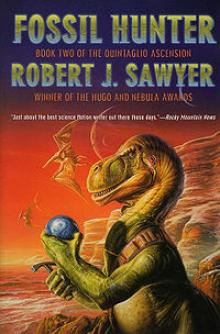 Fossil Hunter qa-2
Fossil Hunter qa-2 Humans np-2
Humans np-2 Biding Time
Biding Time